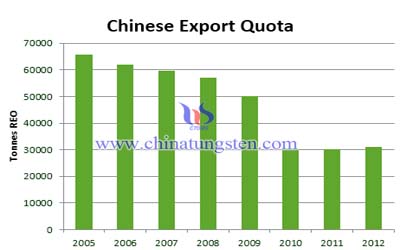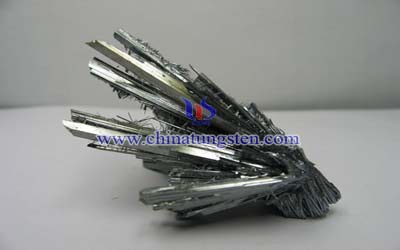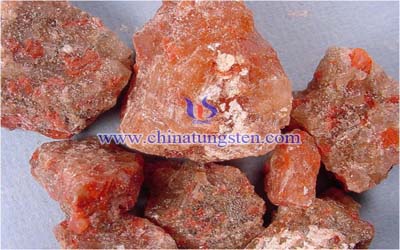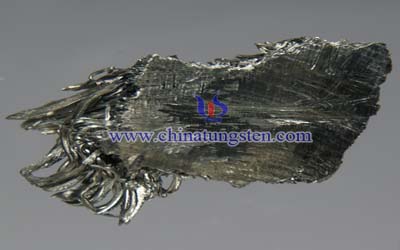Rare Earths in China
- Details
- Category: Rare Earth News
- Published on Monday, 11 March 2013 15:31
- Written by Yuri
- Hits: 2683
China is effectively the monopoly supplier of rare earth elements in the world today. It became the dominant supplier by producing and supplying rare earths in the 1990s and early 2000s at a price western producers could not compete. As a result China anticipated Chinese production in 2012 is 96,000 tonnes according to a November 2012 presentation by industry consultants Industrial Minerals Corporation of Australia (IMCOA).
Chinese demand for rare earths has also continued to rise with organic growth for current applications and new applications have been found for many of the elements and in 2012 this is estimated to be 69% of global demand, or 79,000 tonnes. This is expected to rise to 107,000 tonnes by 2016. At the same time, China’s supply of rare earths is expected to fall as China tightens up environmental controls and curb illegal mining.

The Chinese government is actively trying to consolidate the rare earth industry into major mining groups to assert state control over the supply of rare earths which it views as a strategic asset. These groups will centre on the 3 main rare earth production areas in China:
BaoTou Hi-Tech representing the Inner Mongolia government is taking the lead in the BaoTou area which predominantly produces light rare earths
JiangXi Copper Corp is taking the lead in consolidation in the Sichuan area which produces mainly light rare earths
In the Ionic clay region in the south of China it is expected that consolidation will result in 3 producing groups, China Minmetals, Chinalco and China Mining. This is where most of China’s heavy rare earths will be produced
As a consequence of the rising demand and limited supply China has introduced export quotas which have limited the supply of rare earths to the rest of the world. The Chinese export quota has been reduced substantially since 2005, from 65,580 tonnes to 30,996 tonnes in 2012.
Rare Earth Manufacturer & Supplier: Chinatungsten Online - http://www.chinatungsten.com
Tel.: 86 592 5129696; Fax: 86 592 5129797
Email: sales@chinatungsten.com
Tungsten News & Tungsten Prices, 3G Version: http://3g.chinatungsten.com
Tungsten News & Tungsten Prices, WML Version: http://m.chinatungsten.com
Hunan Issued the First Batch of Total Mining Control Index of 2013
- Details
- Category: Rare Earth News
- Published on Monday, 11 March 2013 15:18
- Written by Yuri
- Hits: 2674
In accordance with the Ministry of Land and Resources, Hunan province has issued an announcement about controlling the mining amount of the first batch of tungsten, antimony and rare earth mines respectively of this year. Requirements are as followed:
Firstly, according to the first batch of index: the index of total tungsten concentrate (with 65% content of tungsten trioxide) control is 11,300 tons, among which the main mining index is 9250 tons and comprehensive utilization indicators are 2050 tons; the index of total antimony ores control is 18,000 tons; as for ion rare earth ores, the index comes to 500 tons.

Secondly, Hunan will continue to suspend accepting new registering application for mining and exploiting tungsten, antimony and rare earth ores, except for those situations having been ruled in the announcement.
Thirdly, all those municipal and continental Ministry of Land & Resources should spare no effort to do the verification work and submit to the provincial Ministry in written form before Mar. 10, 2013. The unfinished index of the total mining control will have no effectiveness.
Fourthly, department of Land and Resource of all levels must take effective measures to strengthen the regulation. All industries should sign a total mining contract, strict implementation of the statistical reporting system, to ensure that the total mining control would achieve tangible results.
Rare Earth Manufacturer & Supplier: Chinatungsten Online - http://www.chinatungsten.com
Tel.: 86 592 5129696; Fax: 86 592 5129797
Email: sales@chinatungsten.com
Tungsten News & Tungsten Prices, 3G Version: http://3g.chinatungsten.com
Tungsten News & Tungsten Prices, WML Version: http://m.chinatungsten.com
Mining and Rare Earth Juniors Lack of Investment Capital
- Details
- Category: Rare Earth News
- Published on Monday, 11 March 2013 11:29
- Written by Yuri
- Hits: 2620
Mining juniors, in general, and rare earth juniors, in particular, are contending with a lack of investment capital, and the writing is on the wall for many, as their projects remain too ‘early stage’, and much too ill defined with regard to end products and their markets, to attract capital (which is bearish and risk averse toward the resource sector at present).
Rare earth exploration juniors are at the edge of the cliff, and the culling of the herd is imminent for many of the blue sky/early stage projects that failed to deliver even an NI 43-101 compliant resource, much less an advance stage development document.
Such is the Darwinian nature of the markets, and there’s something to be said for the channeling of capital to the strongest individuals that remain standing in times of drought and famine.

Two such survivors are Ucore (QTCQX: UURAF) and RER (ASE: REE), which are smallish, right size projects. In the case of Ucore their recent PEA delivered some metrics that set its Bokan property apart from the crowd…not the least of which is an almost absurdly low projection of the CAPEX required to get into production ($221M) and a product mix and form stated to be valuable enough to generate close to $100M per year in pre-tax profit (with a 43% IRR). That’s a bullish return on limited input capital. Ucore plans to be in production in 3 years or so, which places them at the forefront of the international race (along with, in my opinion, RER), to generate HREE’s outside of China.
Ucore estimates that they’ll be producing some 95 TPA of Dy; close to ½ of current US OEM automotive requirements and more than 10X the requirement of US Department of Defense (with which Ucore signed a strategic agreement in Q4 of 2012 for the purpose of advancing their HREE project). DOD is interested in Dy at least partially as an input component in unmanned drones in theaters of war (a topic that has garnered much media attention of late as a bulwark of the Obama administration’s offense strategy in the Middle East). Beyond this, UCU’s Dy output will be readily received by the American automotive industry, as prospective production of EVs and HEV’s continues to grow.
Ucore has yet another ace on the hole with the State of Alaska in their corner. The State has a long history of assisting in the financing of CAPEX to worthy mining projects, with very patient long term, below market interest loans over life of mine. Alaska has a $39B permanent fund, largely the outcome of a robust long term petroleum sector which is now falling into abeyance. So, they’re the rare sovereignty in the western world that has not only significant capital but also the wherewithal to invest in its own future. In Ucore’s case, the stated CAPEX is so low, that the State could singlehandedly guarantee Bokan’s rise to production (witness Alaska’s underwriting of $225M just for the port and road infrastructure at the Red Dog Mine in Central Alaska; an amount which ironically totals more than Bokan’s entire CAPEX requirement). As previously reported, the Goldilocks Principle will gain new credibility in the REE space, as it’s the right size project with the right products, Critical Rare Earths that will ultimately prevail. Ucore’s Bokan is such a project.
Rare Earth Manufacturer & Supplier: Chinatungsten Online - http://www.chinatungsten.com
Tel.: 86 592 5129696; Fax: 86 592 5129797
Email: sales@chinatungsten.com
Tungsten News & Tungsten Prices, 3G Version: http://3g.chinatungsten.com
Tungsten News & Tungsten Prices, WML Version: http://m.chinatungsten.com
10 Million Taken from Baotou Rare Earth High-tech Zone to Strategic Emerging Industries
- Details
- Category: Rare Earth News
- Published on Monday, 11 March 2013 14:08
- Written by Yuri
- Hits: 2590
High-tech Zone timely drawed up the development plan of strategic emerging industries by researching into their product structure, core technology and R&D capabilities, and also, it study detailedly the current situation, development prospects and the growing route of strategic emerging industries. The issue of the views of Baotou Rare Earth High-Tech Industrial Development Zone on accelerating the development of strategic emerging industries minutely arranged the steps, key points and measures of the development of the strategic emerging industries in the High-tech Zone, which says they will contribute 10 million yuan per year to supporting these industries. The strategic emerging industries will be priorly recommended, chose and highly praised when it comes to fighting for capital.
Rare Earth Manufacturer & Supplier: Chinatungsten Online - http://www.chinatungsten.com
Tel.: 86 592 5129696; Fax: 86 592 5129797
Email: sales@chinatungsten.com
Tungsten News & Tungsten Prices, 3G Version: http://3g.chinatungsten.com
Tungsten News & Tungsten Prices, WML Version: http://m.chinatungsten.com
Optimism About HREE Market
- Details
- Category: Rare Earth News
- Published on Monday, 11 March 2013 10:46
- Written by Yuri
- Hits: 2668
Rijkers has updated his report on Northern Minerals (ASX:NTU) following the recent financing package totalling A$58 million coming from Chinese interests. Rijkers’ view is that Northern Minerals has differentiated itself from other REE explorers by focusing on metallurgical studies in conjunction with exploration programs. The company is expecting first production of mixed rare earths oxides in 2016, dominated by the heavies (yttrium 61.6% and dysprosium 11.6%).
Rijkers is more optimistic than most about the sector – well, at least the HREE end of it. He believes the heavy rare earths will come back into focus in 2013 as global equity markets rally to near all-time highs due to a marked up-tick in economic growth expectations and improved political clarity.
“The REE market is itself very small but enormous downstream markets rely on their input at differing stages of the supply chain. REE demand is driven predominantly by two of the fastest-growing economically sensitive areas: renewable energy and high technology,” he writes.
And, despite the low level of investor interest in the HREE equity sector, the past two years have seen industry participants bolster their efforts to secure supply. These efforts have included:
The U.S. establishing a $120 million REE research institute to development new methods of REE production;
The U.S. passing legislation to boost domestic REE production (especially NdFeB magnets critical to defence applications);
Strategic alliance formed between the U.S. Department of Defence and Ucore Rare Metals for dysprosium;
Japan has invested $1.3 billion in REE recycling programs;
Japan has offered $110 million in subsidies for REE projects that reduce its dependency on China;
The E.U. and U.S. have taken legal action through the W.T.O against alleged protectionist Chinese policy;
South Korea and Japan have invested in REE projects through their respective state-owned investment vehicles; and China has tightened environmental controls, implemented policies to create HREE stockpiles and sanctioned investments internationally in HREE projects.
Yet, as he says, the results so far have been muted.

Rijkers continues: “Despite the volatility experienced in the REE sector, taking prices from historically low levels to astronomic heights and subsequently back to the levels of 2010, there are two divergent themes emerging. The rise in HREEs initially reflected the tight demand/supply of the market but also soared to unsustainable levels as speculators entered the market when Japanese demand collapsed due to the Fukushima disaster. This resulted in consumers cutting back based on price destruction which was compounded by the economic and political risks that took hold of the global economy in 2012.
“However, underlying demand for HREEs remains firm due to the robust growth of the downstream industries that they service and a lack of new HREE sources outside of China. There are no substitution materials or alternative technologies that can replace HREEs’ critical role in their respective supply chains without a material cost being incurred. There is also a seismic shift occurring within the demand picture of HREEs which is dominated by China and historically domestic production has exceeded domestic demand. China announced in 2011 that their HREE reserves are finite (8-12 years) and as their REE requirements shift away from lower value LREE applications towards higher value HREE applications, it is likely that China will become a net importer of HREEs over time.
Rare Earth Manufacturer & Supplier: Chinatungsten Online - http://www.chinatungsten.com
Tel.: 86 592 5129696; Fax: 86 592 5129797
Email: sales@chinatungsten.com
Tungsten News & Tungsten Prices, 3G Version: http://3g.chinatungsten.com
Tungsten News & Tungsten Prices, WML Version: http://m.chinatungsten.com





 sales@chinatungsten.com
sales@chinatungsten.com